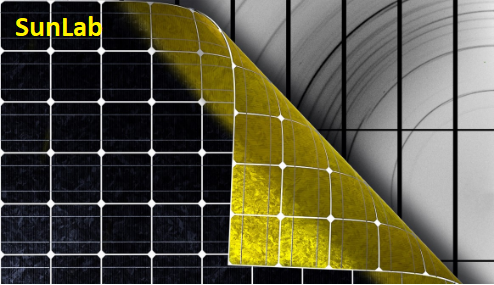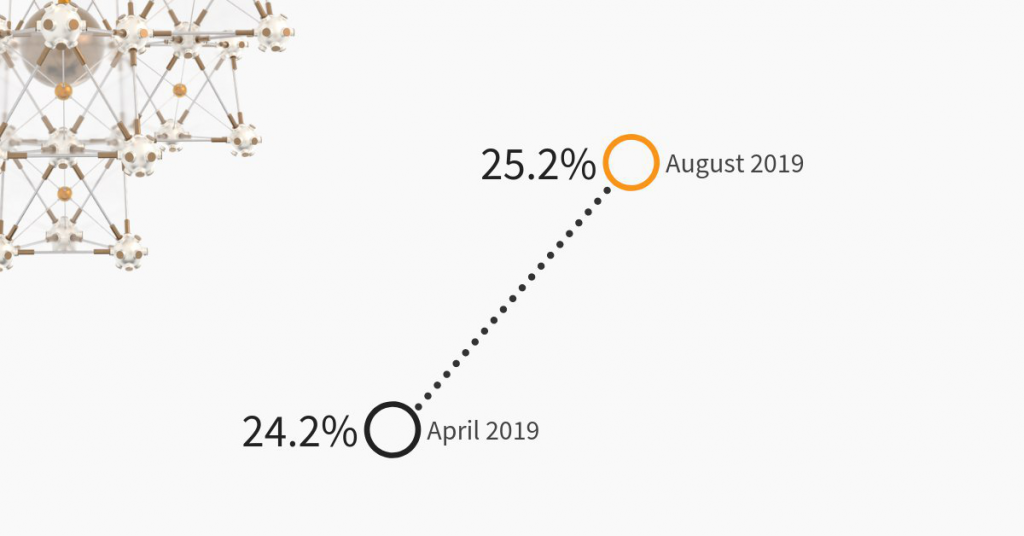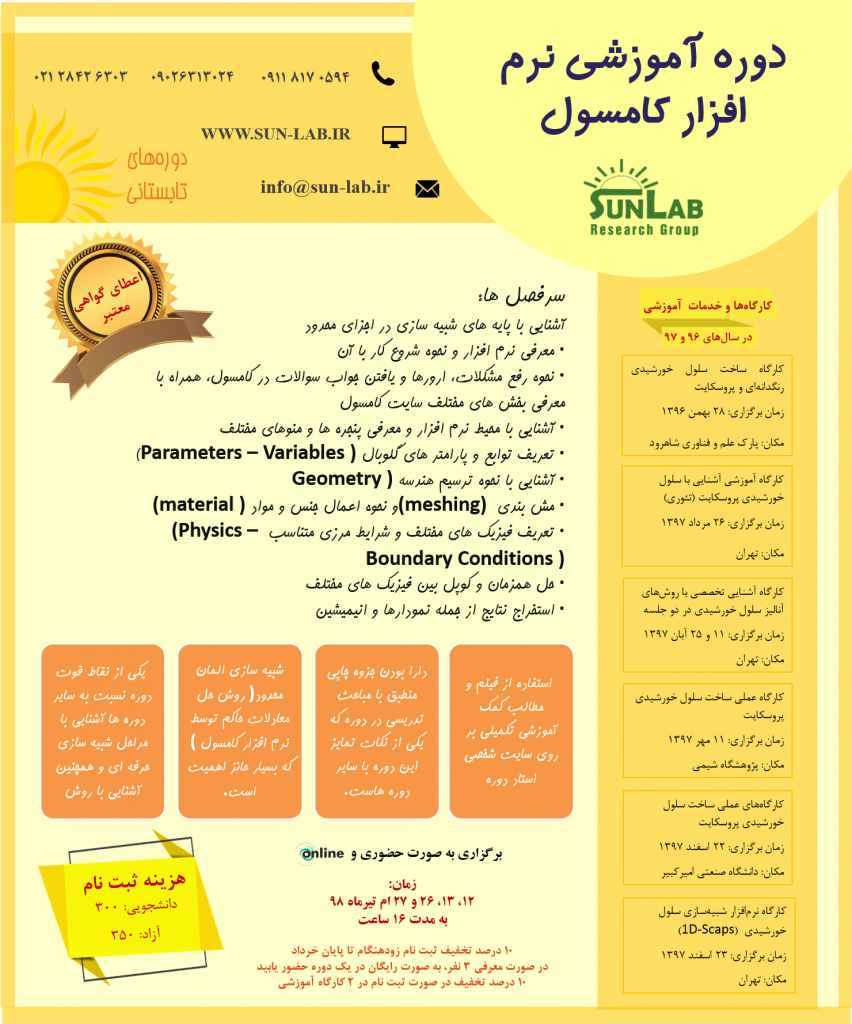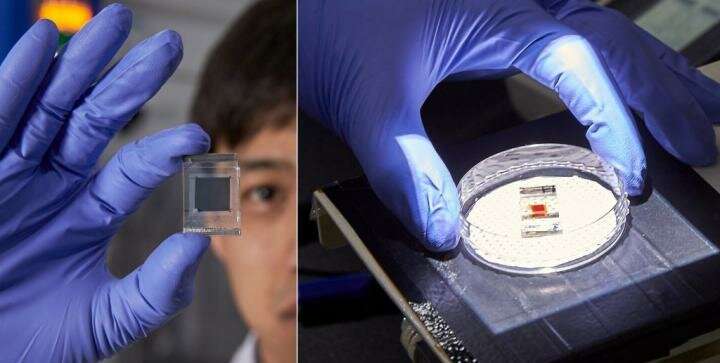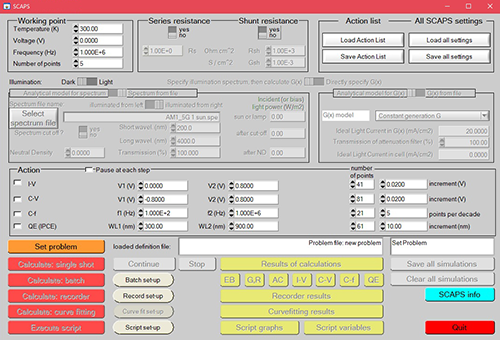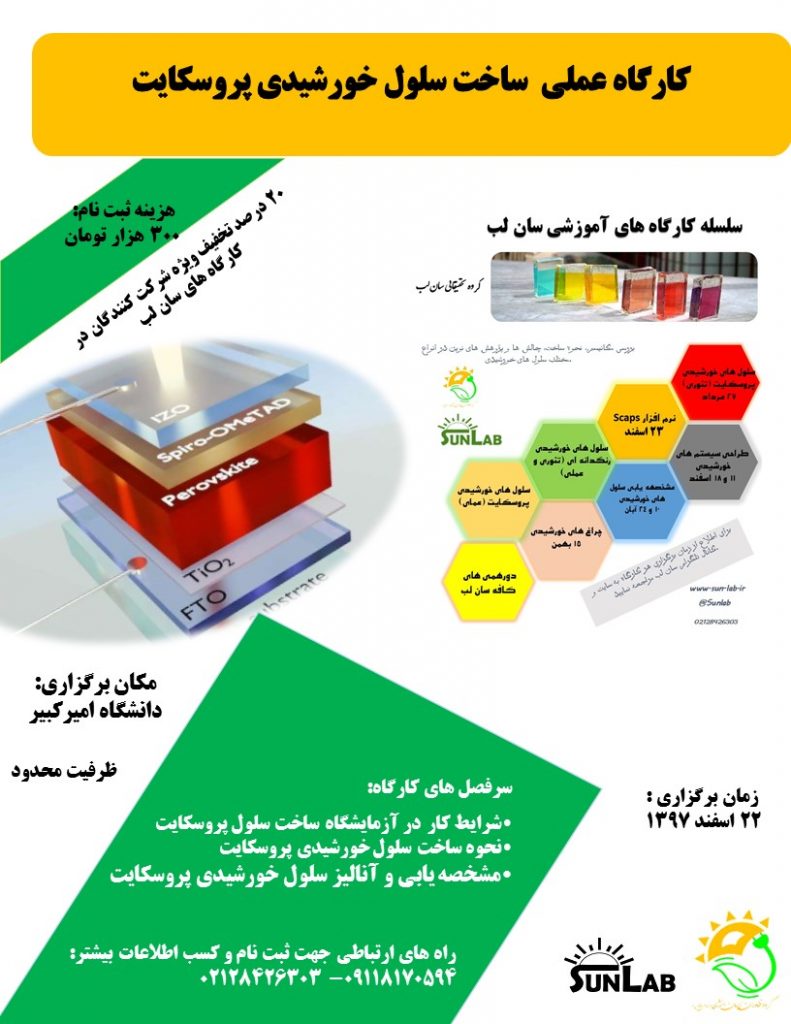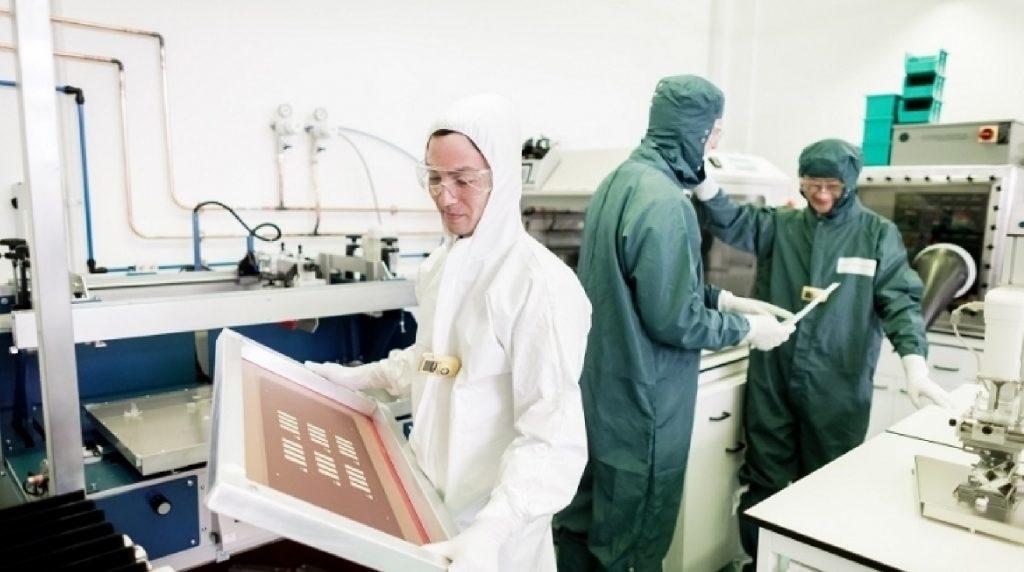حوزه سلولهای خورشیدی پروسکایتی، بدون شک، یکی از مهمترین و جذابترین حوزههای تحقیقاتی جدید در تکنولوژیهای فوتوولتائیکی است. دلیل این مسئله نیز بازده بالای این سلولها است که هماکنون، در مدت زمانی کوتاه، به بیش از ۲۳ درصد رسیده است. با توجه به علاقمندی مخاطبین ما به این نوع از سلولهای خورشیدی، تعدادی از مقالات و ریویوهای مفید و به روز در این حوزه در ادامه آورده شده است.
عنوان مقاله: An Overview of Hybrid Organic–Inorganic Metal Halide Perovskite Solar Cells
لینک مقاله: https://www.sciencedirect.com/science/article/pii/B9780128114797000117
Perovskite solar cells based on hybrid organic–inorganic metal halides as the light absorber are considered promising material in thin film photovoltaic technology due to their high efficiency, cost effective fabrication techniques, and low material costs. The development of solid-state perovskite solar cells has shown a remarkable improvement over the past 4 years. In 2012, the reported photo-conversion efficiency was about 9.7% and in 2016 it has reached over 22%. The improvement in device performances is attributed to the unique characteristics such as a broad spectral absorption range, very high absorption coefficient, high carrier mobility, longer diffusion length, and longer carrier lifetime. Nonetheless, there are still mysteries about how the solar cells behave during current–voltage measurement and problems related to performance degradation, even in ambient environment. In this chapter, we describe the fundamentals of perovskite materials, optoelectronic properties, thin film and device fabrication, performance improvement, and finally, problems related to the commercialization of perovskite solar cells
عنوان مقاله: Use of Carbon Nanotubes in Third-Generation Solar Cells
لینک مقاله: https://www.sciencedirect.com/science/article/pii/B9780323414814000083
CNTs in Perovskite Solar Cells
Perovskite solar cells are a novel type of device that was first fabricated in 2009 (174) and several structures have been reported (175). Excitons are created after light absorption in the perovskite material, which is then separated into holes and electrons to be collected at the metal electrode and the FTO-coated glass electrode, respectively. There are two possible ways to separate the excitons, either by thermal energy in the perovskite material or at the interface between perovskite material and TiO2 or hole transport material. TCFs made from CNTs have been used in perovskite solar cells (176,177) to replace the expensive metal electrode (usually Au) in the fabrication of perovskite solar cells (178). In all cases, the CNT network is part of the hole collection side of the cell. The efficiency improved from 5.14% to 6.87% after replacing the Au with CNT because CNT films can provide a stronger driving force for the hole injection according to the band alignment. The sparsity of the CNT network allows the device to be illuminated from both sides, which makes the application of solar cells as a window a possibility. By adding spiro-OMeTAD (hole transporting substances), the performance of the devices was further improved to 9.9%. Although the PCE of this device was not as high as that from some other literature, it shows the potential to achieve a semitransparent and flexible perovskite solar cell without the energy-consuming process of Au deposition. Additionally, acting as the hole transporting layer with poly(3-hexylthiophene) (P3HT), poly(methylmethacrylate) (PMMA)-functionalized SWCNTs were found to improve the thermal stability significantly because of their better stability compared to the organic hole transport layer (179).
A partially functionalized SWNCT film has been used as a front transparent conducting electrode in place of the ITO electrode in perovskite solar cells. The fabricated device structure was glass or PET/SWCNTs/PEDOT:PSS/CH3NH3PbI3/PC61BM/Al, in which SWCNT film acted as an electron blocking layer. The transparent conducting SWCNT electrode-based planar heterojunction perovskite solar cell achieved a PCE of 6.32%, which is 70% of an ITO-based device (9.05%). A flexible perovskite solar cell made using SWCNT on a PET substrate exhibited a promising PCE (5.38%) (180).
The main advantages of applying CNTs in perovskite devices include cheap fabrication processes and materials, and the potential of two-sided illumination application
عنوان مقاله: Fluorine, a key element for the 21st century
لینک مقاله: https://www.sciencedirect.com/science/article/pii/B9780128129906000027
Fluorinated components in perovskite solar cells
Perovskite solar cells based on organometal halides derive from DSSC technology. In a liquid-based DSSC structure, the adsorption of methylammonium lead halide perovskite (CH3NH3PbX3 (X = Br, I)) on a nanocrystalline TiO2 surface produced a photocurrent with a power conversion efficiency of around 3%–4%, as first discovered in 2009 by Miyasaka.242 The perrovskite optical band gap is between 1.5 and 2.3 eV. The first use of perovskite in a solid state solar cell was in a dye-sensitized cell using CsSnI3 as a p-type hole transport layer and absorber. The efficiency was doubled after 2 years by optimizing the perovskite coating conditions. A long-term, stable, and ~ 10% efficiency perovskite solar cell was developed in 2012 by substituting the solid hole conductor by a liquid electrolyte. Perovskite solar cells are a highly promising photovoltaic technology, because the latest world efficiency record reaches 22.7% (fall 2017 https://www.nrel.gov/pv/ and 243) with the use of cheap organometal halide perovskite materials.
Edge fluorine-functionalized graphene nanoplatelets (EFGnPs-F) protecting a p-i-n structure of perovskite solar cells (i.e., a wide, undoped intrinsic semiconductor region between a p-type semiconductor and an n-type semiconductor region) allows the achievement of 82% stability relative to initial performance over 30 days of air exposure without encapsulation (Fig. 48). The enhanced stability of the methyl ammonium lead iodide (MAPbI3) perovskite-based devices arises from F-substitution on EFGnPs. Indeed, fluorocarbons, such as PTFE and others, are well-known for their superhydrophobic properties and for limiting chemical degradation. These hydrophobic moieties tightly protect perovskite layers from air degradation.244
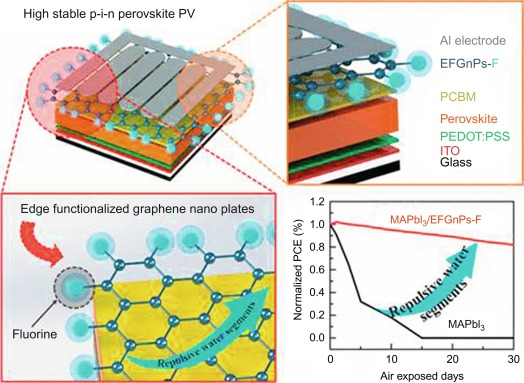
experimental set-up of a p-i-n perovskite solar cell made of methyl ammonium lead iodide (MAPbI3), protected by a thin layer of an edge-fluorinated graphene nanoplatelets (EFGnPs-F). (PCBM is the fullerene derivative [6,6]-phenyl-C61-butyric acid methyl ester). The improvement of hydrophobic properties of EFGnPs-F versus pristine MAPbI3 have been characterized by contact angle measurement (from Kim et al. 244).
p-type inorganic fluorine-doped CsInI3 perovskite, CsInI3 − xFx with x = 0.05, exhibits high hole-mobility semiconductor abilities. The use of a solid component allows to suppress the problem of liquid electrolytes in DSSC. The resulting solid-state dye-sensitized solar cells consist of CsSnI2.95F0.05 doped with SnF2, nanoporous TiO2 and the dye RuII N719 complex, and show conversion efficiencies of up to 10.2%. With a bandgap of 1.3 eV, this enhances visible light absorption on the red side of the spectrum to outperform the typical dye-sensitized solar cells in this spectral region.245
عنوان مقاله: Flexible Perovskite Solar Cells
لینک مقاله: https://www.sciencedirect.com/science/article/pii/B9780128129159000113
Organometal trihalide perovskite solar cells (PSCs) already reached certified power conversion efficiency greater than 22% in laboratory-scale devices. These direct band gap perovskite light absorbers possess novel intrinsic properties such as tunable band gap, high optical absorption, and long diffusion length. Low-temperature solution processing of perovskite absorber film with excellent requisite properties makes this wonder material ideal choice for next-generation low-cost high-performance flexible solar cells. Flexible PSCs have potential to reach niche markets namely portable power sources, lightweight drones, reflectors, etc. Compared to other flexible photovoltaic technologies, complexity of fabricating flexible perovskite solar devices is minimal and cost-effective. In this chapter, a review on material selection and processing, device architecture, thin-film deposition techniques, and stability pertinent to flexible PSCs have been discussed. Up-to-date progress and commercialization techniques such as batch processing and roll-to-roll processing of flexible PSCs are briefed. Potential applications of these flexible PSCs in the niche markets are also discussed
عنوان مقاله: Thin Film Photovoltaics
لینک مقاله: https://www.sciencedirect.com/science/article/pii/B9780128129159000113
Perovskite solar cells stem from dye-sensitized solar cells but have promising solid state structures as well as rapid efficiency leaps (Fig. 18.4), which have now reached 22.7% [2].
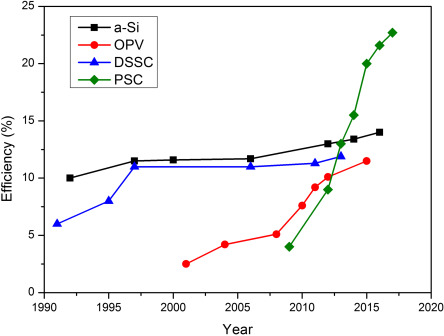
figure 18.4. Comparing the rate of increase in perovskite solar cell efficiencies with the other thin-film PV technologies [19].
Most commonly, CH3NH3PbI3 based organic–inorganic perovskite materials have been used in these types of solar cells due to their high charge carrier mobility. High mobility is important because, together with high charge carrier lifetimes, it means that the light-generated electrons and holes can move large enough distances to be extracted as current, instead of losing their energy as heat within the cell [19]. Moreover, the perovskite solar cells can be deposited by low-temperature methods such as solution process viz. spin coating, spray deposition, and thermal evaporation methods
عنوان مقاله: Commercialization of Large-Scale Perovskite Solar Energy Technology and Scaling-Up Issues
لینک مقاله: https://www.sciencedirect.com/science/article/pii/B9780128129159000137
Perovskite solar cell (PSC) showed the progress in achieving power conversion efficiency from 0 to beyond 20% in recent years. Perovskite use in solar cell technology can help in the efficient use of solar energy. Third generation of photovoltaic (PV) cells has come up with the technologies like dye-sensitized solar cells, PSCs, organic PV, and quantum dot PVs. Perovskite application in solar cells can help in improving efficiency, flexibility, and cost cutting. Concerns like instability, lead toxicity, and scale-up are still under development. Newer technologies to solve the problem of satisfying the flying demands of energy production created thriving ideas of devices and material development, consequently increasing patent filing activities. This chapter maps the progress of this technology through publications and patent analysis so far. This chapter provides an overview of patenting activity from a historical, organizational, geographical, and technological point of view. This exercise is instrumental for private as well as public stakeholder aiming at both internal and external technology creations. It will provide the knowledge about the leading public and private players in prolific countries and their technology focus. This paper also discusses in detail the issue for scaling up the PSC
عنوان مقاله: Heterojunction Perovskite Solar Cells
لینک مقاله: https://www.sciencedirect.com/science/article/pii/B9780128129159000101
Organometallic lead halide perovskite solar cells are emerging as a promising material for high performance photovoltaic devices. In 2009, the hybrid organic/inorganic halide perovskites were first utilized as sensitizers in dye-sensitized solar cells (DSSCs), which has given an efficiency of 3.8%. Within a short span of 6 years, the efficiency has reached 22.1% due to the excellent optoelectronic and mechanical properties of the perovskite material. The structural formula of perovskite is AMX3, where A is an organic cation (ethylammonium, methylammonium, and formamidinium), M is a divalent metal cation (Pb2+ and Sn2+) and X is a halide anion (Cl−, I−, and Br−). The MX6 octahedra forms a three-dimensional (3D) structure and the organic cation A fills the space between the octahedrals. The optical properties of the perovskite depend on the metal halide employed in the structure.



